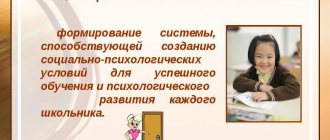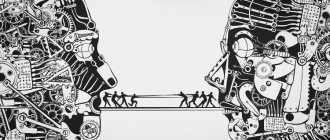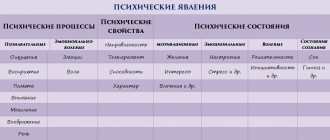Methods of psychological personality correction
Principles of psychological correction
Psychological correction, in an applied sense, arose in Russia in the form of correctional and developmental education aimed at correcting the shortcomings of a child’s personality. L. S. Vygotsky made a significant contribution to the development of the theory and practice of teaching children, developing a method of teaching experiment, the basis of which is the formation of the zone of the nearest child development. This method is considered as a method of psychological correction of cognitive processes and the psychological attitude of the child in the learning process and his socialization. The driving force of development is the child’s cooperation with adults who create his zone of proximal development. An adult is an intermediate link between a child and society. The personality as a whole is leveled out and compensated. Based on the ideas of P. Ya. Troshin and L. S. Vygotsky, many scientists have developed correctional and developmental education programs. Zankov L.V. presented a program of correctional and developmental training in mathematics.; P. P. Blonsky - a program for correcting memory and thinking; A. N. Leontyev - correctional and developmental program for teaching reading and writing; Davydov V.V. - correctional program for types of generalization in teaching; V.V. Davydov, D.B. Elkonin - problem-based learning programs at school, etc. The principles of correctional and developmental education are presented: dynamic perception; productive information processing; correction and development of higher mental functions; motivation to learn.
The development of conceptual views on psychological correction is based on the activity approach to personality. The general psychological principle of the unity of consciousness and activity determines the form of activity of consciousness as a result of behavior and activity, which forms the internal plan of human activity. S. L. Rubinstein argued that changes in the content of activity contribute to the formation of a qualitatively new level of consciousness. A. N. Leontyev concluded that the psychological development of a person is the process of development of his activity, consciousness, and personality. The activity principle of psychological correction is one of the main ones.
So A. A. Osipova identified the following principles of psychological correction:
The principle of unity of diagnosis and correction
as a special type of practical activity of a psychologist;
The principle of normative development
determines the features of the social development situation;
The principle of correction is “top to bottom”.
The content of correctional activities is the creation of a zone of proximal development.
The “bottom up” correction principle
, the content is the socialization of the individual.
A. A. Osipova presented a classification of psychological correction, which differs in the nature of its focus - symptomatic and causal; in terms of content - correction of behavioral aspects; interpersonal relationships, etc.; according to the form of work - individual, group, mixed; by the nature of the correctional impact - directive, non-directive; according to the scale of the tasks being solved - general psychocorrection, private, special. Symptomatic psychocorrection solves the problems of the client’s condition, his experiences, emotional response, tension, etc.
Causal psychocorrection by I. I. Mamaichuk and others is represented by the main models of correctional work to correct and eliminate the causes of deviant child development: medical
— correction of somatic symptoms;
biological
- correction of intact functions of deviant development;
pedagogical
- correction of the child’s pedagogical neglect;
interactional
- correction of interaction, communication, interpersonal relationships.
Psychological correction is carried out in the process of individual activity. The condition for the emergence and development of activity is the formation of its constituent components: motivational and strategic. In order to create conditions for personal growth, it is necessary to clarify the following: assess the social environment, note its positive and negative impact on the motivational-need sphere of the individual; highlight the main qualities of a person, and which of these qualities need to be stimulated, which in some way to suppress; characterize interaction and interpersonal relationships in a social group; arrange specific life goals of an individual in order of their psychological significance, determine a life strategy.
Social factors play a decisive role in the development of the human psyche. When we talk about consciousness, we mean the special activity of the individual’s goal-setting. Reflective awareness helps the individual in meaningfully constructing actions and anticipating their results, which ensures the regulation of behavior.
The process of psychological correction begins with a meeting with oneself. It is during this time that unconscious, but important decisions in the future are made regarding assessing one’s personality and predicting future relationships with other people. A person identifies sociocultural values (religious, worldview) and understands them as his own. Many people pay attention to the degree to which their personality corresponds to social norms of well-being and status accepted in society (marital status, compliance with the “face of the profession,” etc.).
The tasks of psychological correction include accepting oneself, relieving tension, establishing contact, discussing one’s problems, and becoming aware of the necessary information about oneself and one’s professional status.
The leading system of psychological correction is the reflexive system. There are three forms of reflection: primary awareness of one’s “I”; “running” review of your problems; deep study of the problem. During reflection, anticipation (anticipation), returning to the past, asking questions to oneself and searching for answers to them, analyzing one’s behavior and evaluating it are included. Ethical principles are the initial thoughts of the individual, the deepest part of experiences. When realizing the fact of his actions, a person strives to reveal the reasons, highlight the psychological characteristics of the fact, clearly build psychological personal tasks that require independent analysis, highlight the main events of the situation, explain the motives of his behavior, and more. Reflection, creative activity, self-esteem and self-awareness arise. In the process of reflection, a person puts forward hypotheses, testing them, masters new behavior, predicts possible results, trains in changing positions, and gains decision-making experience. At the same time, the motivation of the individual’s actions changes significantly, and ways of further self-education are outlined.
During psychological correction, personal growth occurs - this is a temporary, passing moment of training and education of the will. In the process of personal growth, the search for the authenticity of one’s existence is recreated, a love of knowledge and creativity is fostered. Personal growth forms positive life values, readiness to work, a positive attitude towards the acquired profession, realistic life plans and much more. In the process of personal growth, high social values are instilled: kindness, sensitivity, mutual assistance, respect for work. The stage of personal transformation and attempts to introduce the individual to a new way of living life is highlighted separately. Objectives of psychological correction: development of a program for a positive future of the individual, emotional and existential readiness for personal and behavioral changes. It is necessary to use a special technique for conducting targeted self-observation (A.F. Lazursky). In correctional work, the principles of humanity, a comprehensive and holistic study of the individual, the principle of its dynamic study, and the principle of unity of diagnosis and correction are observed.
The main direction of psychological correction is personality traits and volitional traits. Volitional movements, actions and activities are always conditioned and motivated. In the process of volitional activity, a struggle of motives may take place. This manifests itself in doubts and indecision. Such a struggle can have the character of a painful state when a person is consumed by doubts. Volitional action is carried out for the sake of a goal, subordinates impulses to conscious control and changes the surrounding reality to realize vital goals and objectives. Volitional action is akin to conflict, when a person’s own contradictions collide and internal and external obstacles are overcome.
Volitional qualities and volitional regulation of the individual in life situations are identical, because this is due to the nature of overcoming difficulties. In the process of personal growth, the role of independent overcoming difficulties increases. Socialization in the process of psychological correction as a set of motivational and cognitive aspects is transformed in mental activity when external requirements become internal requirements of the individual.
The cognitive component of psychological correction is the “image of the Self” - the content of a person’s ideas about himself. The “image of the self” can include everything that is significant for a person, everything that allows him, on the one hand, to feel a community with other people, to unite with them, and on the other hand, to distinguish himself from them, to recognize himself as a special, unique person .
A person’s emotional-value attitude towards himself reflects his attitude towards himself as a whole or towards individual aspects of his personality, activities, etc. and is manifested in self-respect, self-esteem, self-esteem and level of aspirations.
The emotional-value component of psychological correction is self-respect, or self-esteem. This is self-acceptance.
The behavioral component of psychological correction determines the possibility of self-regulation, a person’s ability to make independent decisions and manage their behavior.
LASIK/Femto LASIK
LASIK, or laser keratomileusis, is a more modern version of laser vision correction than PRK, which is performed in 2 stages. The first stage is the formation of a corneal flap (flap) from the epithelial layer, for which a special device is used - a microkeratome. The flap is then pulled back to make way for the laser beam.
At the second stage, direct remodeling of the corneal stroma is carried out using ablation (evaporation of tissue) using an excimer laser. After which the corneal flap is placed in its bed.
FemtoLASIK is a modification of the first stage of LASIK surgery. Namely, to form a flap at the first stage, a femtosecond laser is used here; at the second stage, ablation of the corneal stroma is performed with an excimer laser. LASIK and Femto LASIK are the most widely practiced methods of laser vision correction today.
The difference between SMILE and PRK and LASIK
Operations using PRK and LASIK methods are performed with displacement of the surface epithelium of the cornea and modeling (ablation) of the required shape of the cornea in its deep layers using an excimer laser. However, when performing vision correction using the PRK method, patients experience significant pain during the first two days after the intervention, and the rehabilitation period until complete recovery and stabilization of vision lasts at least two months. Whereas when correction is performed using the SMILE technique, complete recovery and maximum visual acuity are possible already on the second day after surgery.
The difference between SMILE and LASIK and Femto LASIK
Carrying out two-stage LASIK and Femto LASIK procedures requires the formation of a certain flap on the surface of the cornea (flap) with further modeling of the corneal stroma with an excimer laser (ablation). When performing vision correction using the SMILE method, only the VisuMax femtosecond laser is used, in one step forming both an optical lenticule in the corneal stroma and a small incision along the periphery of the cornea to remove it. This ensures greater safety of surgical intervention and a reduction in rehabilitation time.
Comparison table of laser correction methods
| PRK | LASIK/Femto LASIK | ReLEx SMILE | |
| Ablation type | Subepithelial | Stromal | Lenticule extraction |
| Laser system | Excimer laser | Excimer laser/Excimer and femtosecond laser | Femtosecond laser VisuMax |
| Recovery period | 1-2 months | 5-7 days | 1-2 days |
| Negative consequences | Pain syndrome, possible complications | Possible complications | Complications are rare, there are no complications of Flap surgery |
ReLEx SMILE
The ReLEx SMILE method or refractive lenticule removal through a small incision is a new generation of laser vision correction technologies. To implement it, innovative developments of femtosecond lasers are used, such as VisuMax from the company Carl Zeiss.
The active introduction of femtosecond technologies into refractive surgery has made it possible to develop completely new safe techniques for laser vision correction. Thus, in 2006, German scientists under the leadership of professors V. Secundo and M. Bloom presented the unique ReLEx technique. The first method they introduced was called ReLEx FLEx and consisted of removing the refractive error-correcting lenticule, an optical lens, through a corneal flap made with a femtosecond laser. The second, improved method is called ReLEx SMILE. Its purpose is to remove the formed optical lens through a small incision along the periphery of the cornea.
The main difference between SMILE and other laser correction options is the ability to correct refractive errors without forming a corneal flap and without the risk of displacing the surface epithelium of the cornea.
Thanks to the introduction of ReLEx SMILE, laser vision correction surgery has become a one-stage procedure, which has significantly reduced the number of potential complications. Now, using only a femtosecond laser (without an excimer laser, which is necessary with other methods), a precisely calculated optical lenticule (lens) is formed in the internal media of the cornea, a small corneal incision is made with the help of it, which does not interfere with vision in the future, and the lenticule is removed through it.








